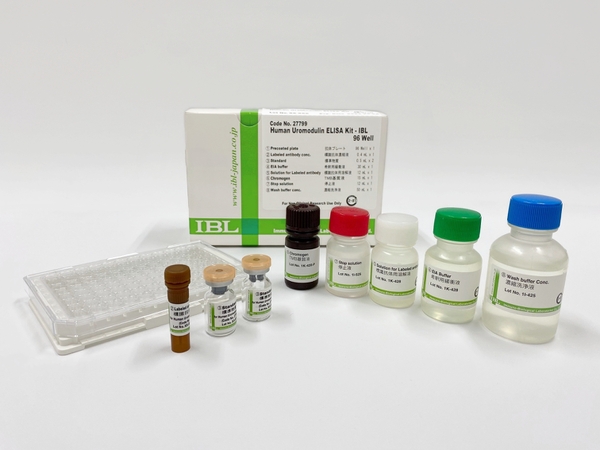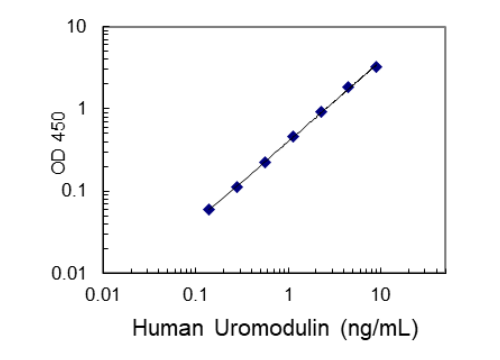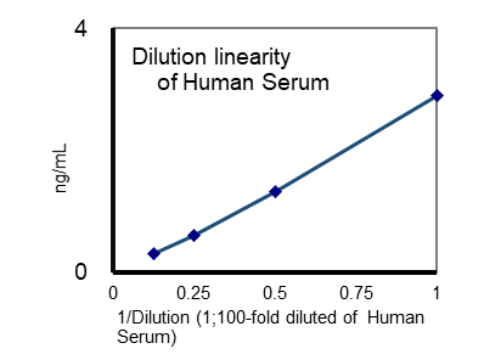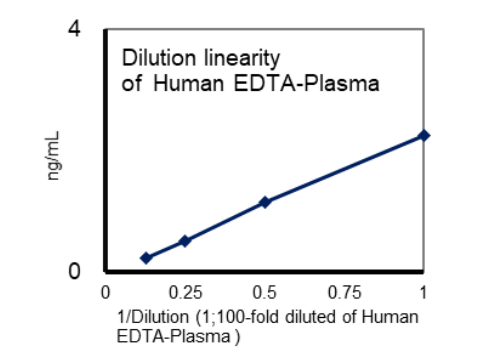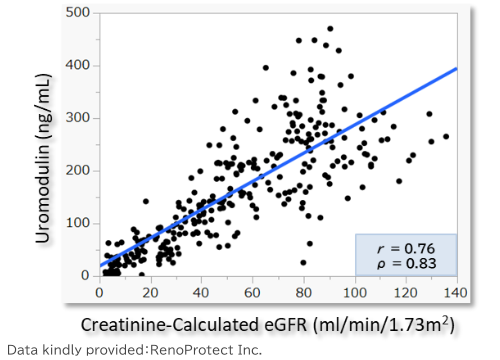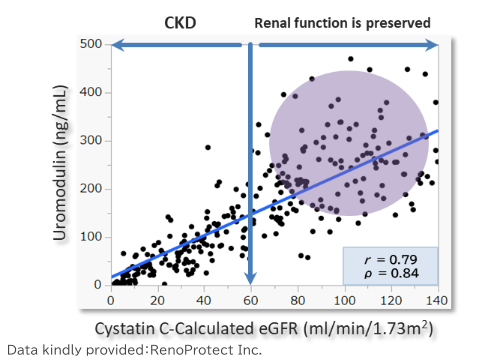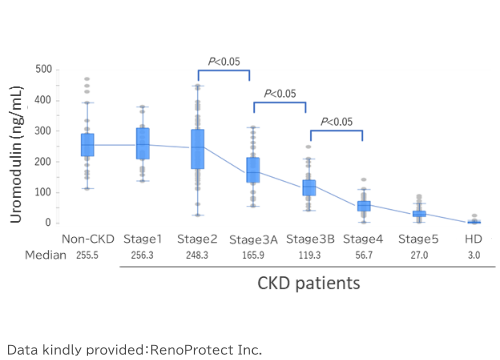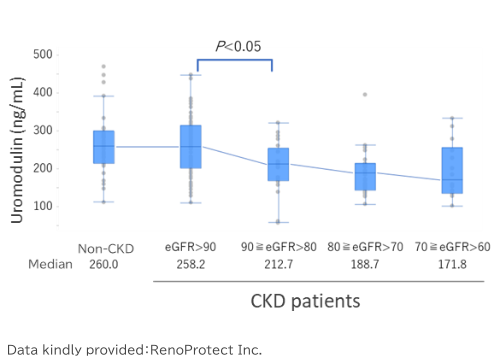- HOME >
- For Researchers >
- Product Search >
- Search Result >
- #27799 Human Uromodulin ELISA Kit - IBL
Product Search
#27799 Human Uromodulin ELISA Kit - IBL
- Intended Use:
- Research reagents
- Measuring Method:
- ELISA
- Sample Types:
- Human
- Measuring Samples:
- Human serum and EDTA plasma.
- Measurement Range:
- 0.14 ~ 9 ng/mL
- Package Size1:
- 96Well
※ The product indicated as "Research reagents" in the column Intended Use cannot be used
for diagnostic nor any medical purpose.
※ The datasheet listed on this page is sample only. Please refer to the datasheet
enclosed in the product purchased before use.
Product Overview
Product Overview
| Product Code | 27799 |
|---|---|
| Product Name | Human Uromodulin ELISA Kit - IBL |
| Intended Use | Research reagents |
| Measuring Method | ELISA |
| Conjugate | HRP |
| Species | Human |
| Measuring Samples | Human serum and EDTA plasma. |
| Measurement Range | 0.14 ~ 9 ng/mL |
| Primary Reaction | 60 minutes at 37℃ |
| Secondary Reaction | 30 minutes at 37°C |
| Sensitivity | 0.07 ng/mL |
| Specificity | Specifically detect Human Uromodulin in human serum or EDTA-plasma. |
| Storage Condition | 2 - 8 ℃ |
| Poisonous and Deleterious Substances | Not Applicable |
| Cartagena | Not Applicable |
| Measuring Service | Not Available |
| Package Size 1 | 96Well |
| Remarks1 | An additional EIA buffer may be required depending on your samples. The EIA buffer is available with charge. Please refer to the details on the datasheet. As the composition of EIA buffer may be different on each product, please use the following product specific EIA buffer for additional use. Product Code: 27799D-30mL Product Name:27799 EIA buffer Size: 30 mL |
Product Description
Product Description
Uromodulin is a highly organ-specific protein that is produced only in the renal tubules of the kidney. Almost all of uromodulin is excreted in the urine, but a small amount is also present in the blood. Uromodulin excreted in urine may be excreted as a single protein, or it may aggregate and be excreted as hyaline casts, depending on the nature of the urine and the state of the disease. On the other hand, it is reported that uromodulin in serum is more suitable for quantitative measurement because it is often excreted as a single substance.
Kidney disease is a condition in which the glomeruli and tubules of the kidney fail to function properly. Symptoms vary from proteinuria, hematuria, and swelling, but there are few subjective symptoms in the early stages. Renal function can be roughly estimated by calculating the estimated glomerular filtration rate (eGFR). Creatinine or cystatin C values are used to calculate eGFR, but both have blind range before detection, and it can happen that only half of the renal function is present at the time of detection.
Blood uromodulin level is positively correlated with renal function, in other words, the measured value might be expected that the changes of renal function might be possibly intuitively evaluated without calculating eGFR, suggesting that blood uromodulin may be sensitive enough to detect slight declines in renal function.
In addition, it may also show abnormally high levels in acute tubular injury and acute interstitial nephritis, and is expected to serve as an indicator for diagnosis and therapeutic evaluation of acute kidney injury. In particular, most cases of acute interstitial nephritis are caused by side effects of drugs and are often difficult to diagnose, often leading to irreversible renal function decline without a diagnosis. It has been suggested that "periodic measurement of uromodulin" may be useful to confirm the safety of administered drugs in the kidney.
And it has been suggested that also high and low levels of uromodulin in blood are associated with mortality, incidence of cardiac events, rate of progression to renal failure, and risk of post-transplant renal failure in CKD patients, and is expected to be an important biomarker.
Keywords:
CKD / eGFR / Kidney function / Tamm–Horsfall protein / Uromodulin
Kidney disease is a condition in which the glomeruli and tubules of the kidney fail to function properly. Symptoms vary from proteinuria, hematuria, and swelling, but there are few subjective symptoms in the early stages. Renal function can be roughly estimated by calculating the estimated glomerular filtration rate (eGFR). Creatinine or cystatin C values are used to calculate eGFR, but both have blind range before detection, and it can happen that only half of the renal function is present at the time of detection.
Blood uromodulin level is positively correlated with renal function, in other words, the measured value might be expected that the changes of renal function might be possibly intuitively evaluated without calculating eGFR, suggesting that blood uromodulin may be sensitive enough to detect slight declines in renal function.
In addition, it may also show abnormally high levels in acute tubular injury and acute interstitial nephritis, and is expected to serve as an indicator for diagnosis and therapeutic evaluation of acute kidney injury. In particular, most cases of acute interstitial nephritis are caused by side effects of drugs and are often difficult to diagnose, often leading to irreversible renal function decline without a diagnosis. It has been suggested that "periodic measurement of uromodulin" may be useful to confirm the safety of administered drugs in the kidney.
And it has been suggested that also high and low levels of uromodulin in blood are associated with mortality, incidence of cardiac events, rate of progression to renal failure, and risk of post-transplant renal failure in CKD patients, and is expected to be an important biomarker.
Keywords:
CKD / eGFR / Kidney function / Tamm–Horsfall protein / Uromodulin
References
References
- Serum uromodulin is a novel renal function marker in the Japanese population. Usui R et al. Clin Exp Nephrol. 2021 Jan;25(1):28-36.PMID: 32915368
- Serum Uromodulin Is a Possible Auxiliary Diagnostic Tool for Acute Tubular Injury and Acute Interstitial Nephritis: A Case Series. Usui R et al. Case Rep Nephrol Dial. 2022 Oct 11;12(3):185-192.PMID: 36518358
Note: Retrieve by PMID number in displayed by abstract: http://www.ncbi.nlm.nih.gov
FAQ
FAQ
-
 Q.Can it be measured in urine sample?
Q.Can it be measured in urine sample? -
 A.Yes, it is measurable, but it is unstable.
A.Yes, it is measurable, but it is unstable.
The dilution ratio should be evaluated and determined by each laboratory, but it is considered as it might be in the range between 10,000 and 20,000 fold. In this case, the commercially available product specific dilution buffer (Code: 27799D-30mL) is additionally required.
uired. -
 Q.Is composition of EIA buffer of each ELISA kit all same? Can it be mixed to use?
Q.Is composition of EIA buffer of each ELISA kit all same? Can it be mixed to use?
ELISA common FAQ -
 A.No it isn't. As constitute of each EIA buffer is different, it cannot be mixed with other lots or EIA buffers contained in other kind of ELISA kits.
A.No it isn't. As constitute of each EIA buffer is different, it cannot be mixed with other lots or EIA buffers contained in other kind of ELISA kits. -
 Q.What is the composition of concentrated wash buffer?
Q.What is the composition of concentrated wash buffer?
ELISA common FAQ -
 A.It contains ordinary Tween and phosphate buffer (0.05% Tween-20 in PB).
A.It contains ordinary Tween and phosphate buffer (0.05% Tween-20 in PB). -
 Q.What is the feature of the plate?
Q.What is the feature of the plate?
ELISA common FAQ -
 A.We use plate that is flat bottom and removable strip type plate (8wellx 12 strips).
A.We use plate that is flat bottom and removable strip type plate (8wellx 12 strips). -
 Q.Can I re-use standard after reconstitution?
Q.Can I re-use standard after reconstitution?
ELISA common FAQ -
 A.Not recommended to re-use standard after reconstitution. Please use it at once after the reconstitution.
A.Not recommended to re-use standard after reconstitution. Please use it at once after the reconstitution.
Please note that there are some exceptions. One time freeze-thaw the standard is acceptable for use after reconstitution for some ELISAs.
Please check the details on each product datasheet. -
 Q.What is different between reagent blank and test sample blank?
Q.What is different between reagent blank and test sample blank?
ELISA common FAQ -
 A.Reagent blank means a well is only added EIA buffer and the purpose is confirming whether the Test sample value is influenced by lack of washing process or other operations. Test sample blank means a well is added EIA buffer and HRP antibody and the purpose is to calculate the background.
A.Reagent blank means a well is only added EIA buffer and the purpose is confirming whether the Test sample value is influenced by lack of washing process or other operations. Test sample blank means a well is added EIA buffer and HRP antibody and the purpose is to calculate the background. -
 Q.How many samples can be measured by this kit?
Q.How many samples can be measured by this kit?
ELISA common FAQ -
 A.The pre-coated plate contained in our ELISA kit is 96 wells plate. We recommend to use 16 wells (2 slits) for standard and 80 wells (10 slits) for 40 samples in duplicate.
A.The pre-coated plate contained in our ELISA kit is 96 wells plate. We recommend to use 16 wells (2 slits) for standard and 80 wells (10 slits) for 40 samples in duplicate. -
 Q.What is LOD (Limit of Detection)?
Q.What is LOD (Limit of Detection)?
ELISA common FAQ -
 A.It (LOD) is defined as sensitivity that is calculated using the NCCSL method. Please refer to a datasheet of each product.
A.It (LOD) is defined as sensitivity that is calculated using the NCCSL method. Please refer to a datasheet of each product. -
 Q.What is LOQ (Limit of Quantification)?
Q.What is LOQ (Limit of Quantification)?
ELISA common FAQ -
 A.It (LOQ) is the lowest value of measurement (standard) range. Please refer to a datasheet of each product.
A.It (LOQ) is the lowest value of measurement (standard) range. Please refer to a datasheet of each product. -
 Q.What is the definition of Over Night (O/N) reaction?
Q.What is the definition of Over Night (O/N) reaction?
ELISA common FAQ -
 A.It means that the reaction is required more than 16 hours unless otherwise specifically defined it on a datasheet of each ELISA product.
A.It means that the reaction is required more than 16 hours unless otherwise specifically defined it on a datasheet of each ELISA product. -
 Q.What is the specification of quality control for ELISA product release?
Q.What is the specification of quality control for ELISA product release?
ELISA common FAQ -
 A.The information of specification is available on individual lot specific CoA. Please contact us with your reference lot number for obtaining of specific CoA.
A.The information of specification is available on individual lot specific CoA. Please contact us with your reference lot number for obtaining of specific CoA. -
 Q.What is the number (e.g. 432143214321) at the edge of strips of the plate?
Q.What is the number (e.g. 432143214321) at the edge of strips of the plate?
ELISA common FAQ -
 A.According to the plate maker (ThermoFisher), it does not have any specific meaning as it is just the number of molds.
A.According to the plate maker (ThermoFisher), it does not have any specific meaning as it is just the number of molds. -
 Q.How to wash an ELISA plate?
Q.How to wash an ELISA plate?
ELISA common FAQ -
 A.Washing it by an auto-washer is highly recommended.
A.Washing it by an auto-washer is highly recommended.
If it is not available, please refer to the demo video (only 2 mins) using a washing bottle. -
 Q.The wells turned black during the test with the kit.
Q.The wells turned black during the test with the kit.
ELISA common FAQ -
 A.It is possible that the wells were not washed sufficiently during the washing process after the HRP-labeled antibody reaction.
A.It is possible that the wells were not washed sufficiently during the washing process after the HRP-labeled antibody reaction.
Be sure to wash the wells enough times as described in the data sheet with washing buffer of more than 350 µL.

